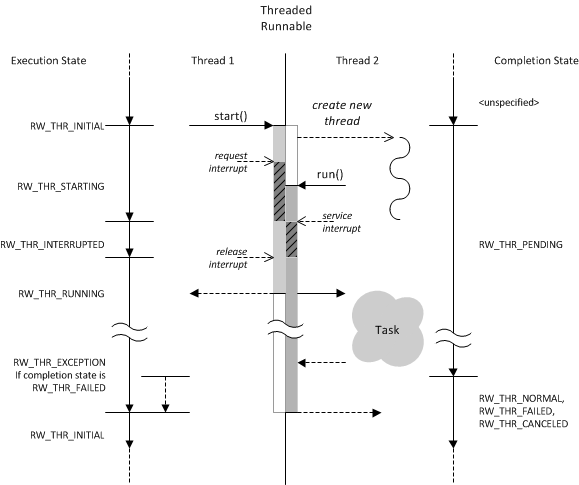Starting Threaded Runnables
An asynchronous, threaded runnable creates its own thread to accomplish its tasks. When you call RWRunnable::start(), the runnable launches a new thread to execute the run() member. The process is explained in the following steps and is illustrated in Figure 10.
1. When first constructed, a threaded runnable object is initialized with an execution state of RW_THR_INITIAL[1] and a completion state of RW_THR_PENDING{1}.
2. The runnable enters an execution state of RW_THR_STARTING[2] before creating the new thread. The starting thread requests and waits for the new thread to interrupt.
The interrupt occurs before the new thread enters its run() member. This step insures that the thread doing the starting does not return from the start() function until the new thread completes any necessary initialization. Once the new thread is interrupted, the Threading package sets the initial scheduling policy and priority for the thread.
3. Once the new thread begins execution, it attempts to service the interrupt request. This causes the execution state to change to RW_THR_INTERRUPTED[7].
4. The start policy of the runnable is evaluated. Depending on the current policy setting, the new thread is either left in the interrupted state or released. In either case, the start() function returns control to the calling thread.
a. If the threaded runnable has a start policy value of RW_THR_START_INTERRUPTED, the start() function returns without releasing the interrupt.
b. If the threaded runnable has a start policy of RW_THR_START_RUNNING, the interrupt is released by the starting thread, the execution state is changed to RW_THR_RUNNING[9] state, and the start() function returns a completion state of RW_THR_PENDING to the calling thread. For more information about the start policy and other thread attributes, see Thread Attributes.
5. Once a runnable’s thread successfully completes its activities and returns from the run() function, the runnable’s execution state is changed to RW_THR_INITIAL[4] and its completion state is set to RW_THR_NORMAL{2}.
6. If an exception thrown from within the run() member is successfully caught within the runnable, the completion state changes to RW_THR_FAILED{3} and the execution state briefly changes to RW_THR_EXCEPTION[5] before changing back to the RW_THR_INITIAL[6] state.
Figure 10 – Start operation for threaded runnables — interaction and timing






